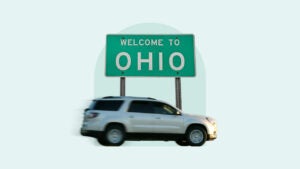Ohio car insurance laws

Like most U.S. states, Ohio requires all drivers to carry vehicle insurance. By law, all auto insurance policies in the state must include liability insurance that meets certain minimum thresholds. But minimum coverage may not offer enough financial protection for you and your household. In this article, Bankrate’s insurance editorial team reviews Ohio auto insurance laws to help you understand and navigate the state’s insurance marketplace.
Car insurance laws in Ohio
Car insurance is mandatory in the state of Ohio. If you own a car, you’ll need to carry insurance on your vehicle in order to avoid legal penalties. State law requires that every auto insurance policy include certain minimum amounts of bodily injury liability and property damage liability coverage, but other types of insurance are optional.
Keep the following in mind regarding Ohio car insurance laws:
- You must carry proof of insurance with you: When you receive insurance cards from your insurance company, be sure to keep them in your vehicle so that you’re able to provide proof of financial responsibility at traffic stops or accident scenes.
- You could lose your license if you’re uninsured: Driving without insurance in Ohio is illegal, and anyone caught operating a motor vehicle without proof of insurance may lose their license and vehicle registration until they purchase insurance and pay the reinstatement fee.
- It is illegal to lend your car to someone who is uninsured: In Ohio, you cannot let a friend or family member borrow your vehicle if they are uninsured. Every driver must have some type of insurance or proof of financial responsibility in order to operate a vehicle, even if they do not own a car themselves.
Technically, Ohio allows drivers to meet the state’s financial responsibility requirements without purchasing an insurance policy. The alternatives to auto insurance in Ohio include:
- A certificate of self-insurance, if you own more than 25 vehicles
- A $30,000 bond from an insurance company or surety
- A certificate from the Bureau of Motor Vehicles (BMV) stating that you have $30,000 on deposit with the state treasurer
Generally, the alternatives to Ohio’s auto insurance laws are more expensive than simply purchasing a car insurance policy with minimum liability insurance.
Liability insurance requirements in Ohio
Ohio state law requires liability insurance in order to drive legally in the state. At a minimum, drivers must maintain 25/50/25 policy limits. This means:
- $25,000 in bodily injury liability coverage per person
- $50,000 in bodily injury liability coverage per accident
- $25,000 in property damage liability coverage per accident
Sticking to a liability-only policy that meets these limits will keep your insurance costs as low as possible — but minimum insurance may not provide enough financial protection to cover all of your assets. If you’re at fault in a serious accident, you could quickly exhaust a minimum coverage policy’s liability limits, leaving you exposed to lawsuits that could drain your finances.
Minimum liability insurance also won’t cover damage to your own vehicle or any of your medical expenses. Liability insurance only covers damage you cause to others.
If you’d like more insurance coverage than the state minimum but aren’t sure how much you need, you may want to speak with an insurance agent licensed to sell policies in Ohio. An agent may suggest raising your liability limits above the minimum required by the state, opting for full coverage insurance or adding optional coverage like roadside assistance to your policy.
Is Ohio a no-fault state?
No, Ohio is not a no-fault state. Ohio is considered to be a fault state, also called a tort state. This means that drivers aren’t required to carry no-fault personal injury protection (PIP) insurance, which offers first-party coverage for medical costs. In no-fault states, this coverage reduces liability claims by allowing drivers to file medical claims with their own insurance company.
PIP coverage isn’t available in Ohio, but drivers can choose to purchase medical payments (MedPay) coverage, which plays a similar role. However, because it’s not required by law, many drivers in Ohio don’t carry MedPay and may rely on liability claims to get car accident injuries covered.
Penalties for driving without insurance in Ohio
The penalties for driving without minimum car insurance in Ohio are serious. Any driver that is caught not complying with Ohio car insurance laws will automatically have their license suspended. Here are the consequences of driving without insurance in Ohio:
- First offense: The driver’s license will be suspended until they can show proof of insurance. The driver must pay a $40 reinstatement fee to get their license back.
- Second offense: The driver’s license will be suspended for one year, and they must pay a $300 reinstatement fee to get their license back.
- Third offense and beyond: The driver’s license will be suspended for two years, and they must pay a $600 reinstatement fee to get their license back.
Drivers who fail to surrender their driver’s license are charged a $50 fee. Additionally, all drivers who are caught driving without insurance are required to purchase an SR-22 certificate to demonstrate proof that they have proper insurance going forward, and which will typically be required for three to five years, depending on the offense.
Additional auto insurance coverage options in Ohio
If you’re interested in getting a car insurance policy that covers more than the bare minimum required by law, you may want to speak with an insurance agent about adding some of these types of insurance to your policy:
- Collision insurance: Collision insurance pays to repair vehicle damage after a covered accident. This policy also covers accidents with stationary objects.
- Comprehensive insurance: Comprehensive insurance pays to repair vehicle damage stemming from non-accident situations, like falling objects, fire or theft.
- Gap insurance: Gap insurance may be a beneficial coverage for drivers who lease or finance a new vehicle. If your car is totaled after a covered accident, gap insurance will pay out the difference between the car’s value and the balance remaining on your loan.
- Roadside assistance: Roadside assistance is a popular add-on coverage that provides basic car repairs, towing, extrication, fuel delivery, lockout services, battery replacement and more. This coverage is available from most insurance companies.
- Medical payments (MedPay): If you or a household member are injured in a car accident, MedPay can help to cover the cost of medical treatment regardless of who was at fault in the accident. This coverage may supplement your health insurance.






